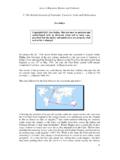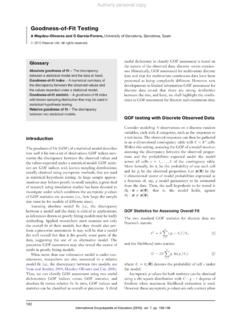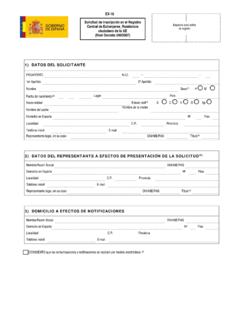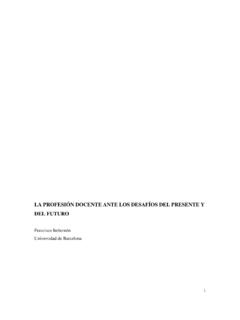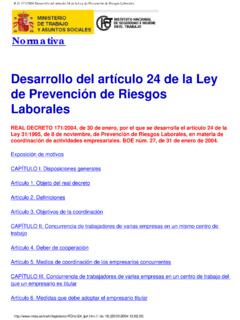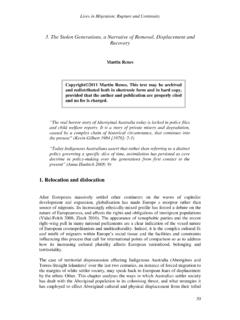Transcription of Against the mainstream: Nazi privatization in 1930s Germany
1 Against the mainstream: Nazi privatization in 1930s Germany Germ Bel* Universitat de Barcelona i ppre-IREA Contact data: Germ Bel Ppre-IREA Departament de Pol tica Econ mica i EEM. Torre 6, planta 3 Facultat d Econ miques UB Avd. Diagonal 690 08034 Barcelona SPAIN Tel: e-mail: * This research project has received financial help from the Fundaci n Rafael del Pino, and from the Spanish Ministry of Science and Technology under the Project BEC2003-01679. Much of the work on this paper was done while I was visiting scholar at Harvard University. Preliminary versions of the paper have been presented at Georgetown University. Comments and suggestions from Xavier Coller, Jost D lffer and Luis Quiroga and an anonymous referee have been useful. I am fully responsible for any remaining errors.
2 1 Against THE MAINSTREAM: NAZI privatization IN 1930s Germany Abstract: The Great Depression spurred State ownership in Western capitalist countries. Germany was no exception; the last governments of the Weimar Republic took over firms in diverse sectors. Later, the Nazi regime transferred public ownership and public services to the private sector. In doing so, they went Against the mainstream trends in the Western capitalist countries, none of which systematically reprivatized firms during the 1930s . privatization in Nazi Germany was also unique in transferring to private hands the delivery of public services previously provided by government. The firms and the services transferred to private ownership belonged to diverse sectors. privatization was part of an intentional policy with multiple objectives and was not ideologically driven.
3 As in many recent privatizations, particularly within the European Union, strong financial restrictions were a central motivation. In addition, privatization was used as a political tool to enhance support for the government and for the Nazi Party. Key Words: privatization , Public Enterprise, Nazi Economy, Germany . JEL Codes: G38, L32, L33, N44 2I. Introduction privatization of large parts of the public sector was one of the defining policies of the last quarter of the twentieth century. The privatizations in Chile and the United Kingdom, implemented in the 1970s and 1980s, are usually considered the first privatization policies in modern history ( Yergin and Stanislaw, 1998, ). A few researchers find earlier instances: Some economic analyses of privatization ( Megginson, 2005, p.)
4 15) identify partial sales of state-owned firms in Adenauer s Germany in the late 1950s and early 1960s as the first large-scale privatization program, and others argue that, though confined to just one sector, the denationalization of steel and coal in the United Kingdom during the early 1950s should be considered the first privatization ( Burk, 1988; Megginson and Netter, 2003, p. 31). None of the contemporary economic analyses of privatization takes into account an important, earlier case: the privatization policy implemented by the National Socialist (Nazi) Party in Germany . The modern literature on privatization , the recent literature on the twentieth-century German economy ( Braun, 2003) and the history of Germany s publicly owned enterprises ( Wengenroth, 2000) all ignore this early privatization experience.
5 Some authors occasionally mention the re- privatization of banks but make no further comment or analysis ( Barkai, 1990, p. 216; James, 1995, p. 291). Other works, like Hardach (1980, p. 66) and Buchheim and Scherner (2005, p. 17), mention the sale of State-owned firms in Nazi Germany only to support the idea that the Nazi government opposed widespread state ownership of firms and do not carry out any analysis of these privatizations. It is a fact that the government of the Nazi Party sold off public ownership in several State-owned firms in the mid- 1930s . These firms belonged to a wide range of sectors: steel, mining , banking, local public utilities, shipyards, ship-lines, railways, etc. In addition, the delivery of some public services that were produced by government prior to the 1930s , especially social and labor-related services, was transferred to the private sector, mainly to organizations within the party.
6 In the 1930s and 1940s, many academic analyses of Nazi economic policy discussed privatization in Germany ( Poole, 1939; Guillebaud, 1939; Stolper, 1940; Sweezy, 1941; Merlin, 1943; Neumann, 1942, 1944; Nathan, 1944a; Schweitzer, 1946; Lurie,1947).1 1 Other less academic works from this period also comment on the privatization in Nazi Germany [ Reimann (1939) and Heiden (1944)]. 3 Most of the enterprises transferred to the private sector at the Federal level had come into public hands in response to the economic consequences of the Great Depression. Many scholars have pointed out that the Great Depression spurred State ownership in Western capitalist countries ( Aharoni, 1986, pp. 72 and ff.)
7 ; Clifton, Com n and D az Fuentes, 2003, p. 16; Megginson, 2005, pp. 9-10), and Germany was no exception. But Germany was alone in developing a policy of privatization in the 1930s . Therefore a central question remains: Why did the Nazi regime depart from the mainstream policies regarding State ownership of firms? 2 Why did Germany s government transfer firms and public functions to the private sector while the other Western countries did not? Answering these questions requires an analysis of the objectives of Nazi privatization . While some of the analyses in the 1930s and 1940s are valuable, their authors lacked the theories, concepts and tools available to us today. The recent economic literature has shown the multiplicity of objectives usually targeted by privatization policies (Vickers and Yarrow, 1988, 1991) and the general and widespread priority of financial objectives within the larger framework of multiple and coexisting objectives (Yarrow, 1999).
8 In addition, modern theoretical developments have provided valuable insights into the motives of politicians choosing between public ownership and privatization (Shleifer and Vishny, 1994) and the consequences of each option for political rent seeking, through either excess employment or corruption and financial support (Hart, Shleifer and Vishny, 1997). Also, the theoretical literature has provided interesting results concerning the use of privatization to obtain political support (Perotti, 1995; Biais and Perotti, 2002). With the analysis of privatization in Nazi Germany this paper seeks to fill a gap in the economic literature. On the one hand, I document in detail the course of privatization in the period from the Nazi take-over until These limits are chosen because all the major 2 A recurring question in the literature on Nazi economic policy is why the Nazis refrained from implementing a policy of wide-scale nationalization of private firms [See Buchheim and Scherner (2005) for a recent example].
9 Indeed, this question is interesting since the Nazis official economic program and their electoral manifestos regularly included this proposal. However, it is not a central concern of this paper. It is worth noting that by rejecting large-scale nationalization, the Nazi government joined the mainstream in Western capitalist countries, which were, in the 1930s , more given to intervention through regulation and fiscal policy. As explained in Megginson (2005, p. 10), nationalization of private firms was not a major policy in Western capitalist countries once the worst of the Great Depression was over. 3 Choosing this period is also very useful because it permits us to avoid confusion between the processes of privatization and Aryanization. As explained by James (2001, p. 38-51), after 1936-37 there was an intensification of the Aryanization process, in what was a state-driven aryanization.
10 Many of the largest 4reprivatization operations had been concluded before the end of 1937. Some of the privatization operations explained in this paper have not been previously noted in the literature. On the other hand, analyzing the Nazi privatization with modern tools and concepts allows us to conclude that the objectives pursued by the Nazi government were multiple. Of particular relevance were the increased political support and, especially, a combination of increased revenue and expenditure relief for the German Treasury. In short, these motives are quite similar to those that have driven privatization policies in most EU countries. The rest of the paper is organized as follows. First, I document the Nazi privatization policy, and present a quantitative comparison with more recent privatizations.
